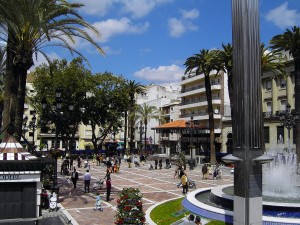Study in Huelva, Spain
Study in Huelva, Spain

Located in Southwestern Spain, Huelva is a city situated in the autonomous community of Andalusia, where it serves as the capital of the province of Huelva. The city is situated along the coast of the beautiful Gulf of Cádiz, at the confluence of the Odiel and Tinto rivers. A very historical city, Huelva has been inhabited since 3000 BC. Today, according to the latest available census data, the city has a population of roughly 150,000 permanent inhabitants. Huelva is home to Recreativo de Huelva, the oldest football club in Spain.
Among the attractions to visit in the Province of Huelva are the Columbus sites. These sites include the city of Huelva, Moguer, Palos de la Frontera, and the Rábida Monastery. La Rábida is where Columbus sought the aid of the Franciscan brothers in advancing his project of discovery. They introduced him to local rich sailors (the Pinzón brothers), and, eventually, arranged a meeting in Seville with Ferdinand and Isabella.
Things to Do and See in Huelva, Spain
Being one of the oldest cities in the region, Huelva offers a wealth of interesting things to do and see. Some of the more popular attractions include:
The Columbus Sites
The city of Huelva and its surrounding towns is a Mecca for those interested in Christopher Columbus, a place with a number of significant tourist attractions relating to the famous explorer.
Cristóbal Colón (as Columbus is known in Spain), is thought by most to have been born in Genoa, Italy around 1451. After years of seeking funding support for an expedition which was to find a sea route to Asia, Columbus finally came to an agreement with King Ferdinand and Queen Isabella of Spain. They would (along with a number of Italian financiers) back his expedition in return for dominion over any new lands the explorer might discover. Columbus would be awarded titles and, of course, a percentage of any fortune that was made. The rest, of course, is world history.
La Rábida, the Palos de la Frontera and Moguer are three of the key sites in the Columbus story, all of which lie along the eastern bank of the Rio Tinto estuary and can be visited in a 40 km return trip from Huelva. At least 10 buses a day run from Huelva bus station to La Rábida and Palos de la Frontera, many of them continuing to Moguer. There are several accommodation options for staying at these sites overnight.
Seven kilometers south of Huelva city, where the Tinto and Odiel rivers meet, is the 15th-century Franciscan monastery known locally as the Monasterio de Santa María de la Rábida. For those interested in the life and voyages of Christopher Columbus, this is one of three places to visit around Huelva where people can gain a vast amount of knowledge. The other two sites are the nearby town of Palos de la Frontera, where Columbus found the crew that would join him on his first voyage; and the Convento de Santa Clara in Moguer, which Columbus frequently visited.
La Rábida is the town in which Columbus stayed between 1491 and 1492 while waiting for financial backing from the Catholic Monarchs, Ferdinand and Isabella, for his voyage to the New World. The monastery at which he stayed was constructed in 1412 on the site of a Moorish stronghold; 'Rábida' is an Arabic word meaning fortress. Its Moorish influences can still be seen in its Mudéjar architecture, including the stunning cloister. The monastery has a 14th-century Gothic-Mudéjar church, where Captain Martín Alonso Pinzón, who sailed with Columbus in one of his ships, is buried.
La Rábida was damaged by the Lisbon earthquake in 1755 and was left derelict in 1835 only to be restored a few decades later. It reopened in 1856, at which time it was declared a national monument. In 1920, Franciscan monks returned to the monastery and monks continue to live there today.
Gran Teatro (Grand Theater)
A magnificent neo-classical building dating back to 1923, the Gran Teatro, or Grand Theater, plays host to a wide variety of crowd-loving shows, including those consisting of opera, dance, cinema and theater. Shows are offered throughout the year here and reservations are always a good idea.
Museo Provincial (Provincial Museum)
Huelva's Museo Provincial, or Provincial Museum, which is housed in a modern building on the Avenida Sundheim, has an interesting archaeological collection, with objects from the megalithic sites of La Zarcita at Santa Bárbara de las Casas and El Pozuelo at Zalamea la Real; Tartessian treasure from the necropolis at La Joya; and Phoenician and Greek artifacts discovered in excavations within the city. Moorish artifacts are also on display in the Museo Provincial.
In the mining section of the museum, visitors will find rare objects of Roman mining activity, including the museum's biggest find, a huge Roman water wheel from Río Tinto, used by slaves for drawing water out of the mines.
The highlights of the Provincial Museum’s fine art collection are the works by Daniel Vázquez Díaz, a 20th-century artist from nearby Nerva, whose murals on the life of Christopher Columbus can be seen at the aforementioned La Rábida monastery just outside the city. One of his paintings is the Cubist-influenced portrait of his friend and contemporary, the poet Juan Ramón Jiménez from Moguer. The museum also has a space for wonderful temporary exhibitions which are housed there at certain times of the year. The Museo de Huelva is located at Alameda Sundheim 13 and can be reached by taking the number 3 or 5 bus from Plaza de las Monjas in the city center.

